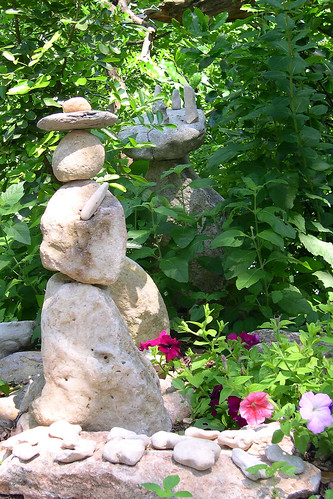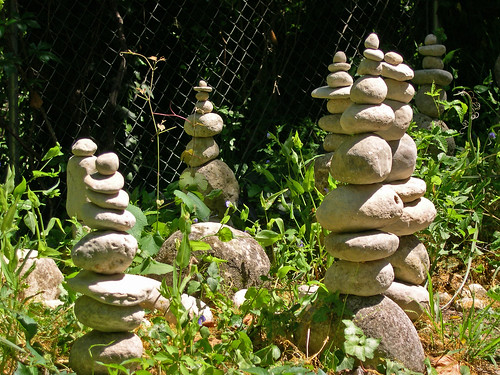Robin Chotzinoff flattered me in her story on garden blogging, comparing my compulsion for note-taking and record-keeping to Thomas Jefferson’s. I mentioned he was one of my garden heroes and inspirations. I wish I were even half as thorough in my records as he.

Luckily for us, he did not ever fulfill his resolution to entirely abolish pen and paper from his farm. Quite the contrary. He wrote in his garden and farm books whenever he was at home. I’m betting that if Thomas Jefferson were alive today he would be a garden blogger. He was curious about everything, passionate about gardening, and loved sharing what he knew and learning from others.
New varieties of plants thrilled him; his garden motto seems to be “Discovery”. The Americas were, after all, a whole new world of plants. Before sending Meriwether Lewis on the famous expedition he sent him to Philadelphia for nine months to study botany. In contrast to our century, where we keep lists of plants that have gone extinct under our stewardship, Jefferson was adding plants through discovery or hybridization. “The greatest service which can be rendered any country is to add a useful plant to its culture,” writes our third president and author of the Declaration of Independence.
Using the technology of his time, he wrote a copious number letters swapping knowledge and always begging seeds, bulbs and plants to try. “Your favor of the 7th came duly to hand and the plant you are so good as to propose to send me will be thankfully recd. The little Mimosa Julibrisin you were so kind to send me last year is flourishing.” he writes William Hamilton from Washington in 1806. In this same letter he lays out his plans for farm improvements when his term as president is over. “…my views and attentions are all turned homewards.” he prefaces several long paragraphs on his plans for farms when he gets home, concluding with, “…the subject runs away with me whenever I get on it.”
He is aware of the social obligation of his written connections. Correspondence, like blogging, establishes a relationship, one that must be kept up by both writer and reader. “In matters of correspondence as well as money, you must never be in debt.”
Doesn’t it humanize these great historical figures to know that in 1796 Thomas Jefferson wrote to George Washington saying, “I put away this disgusting dish of old fragments & talk to you of my peas & clover.” He then goes on in great detail talking about how many tons per acre of wheat he has grown, how tall the stalks are, how his older fields are exhausted, his plans for crop rotation, and how he’s built a Scotch threshing machine from a model someone sent him. He modified the plan to more easily move it from field to field.
In his travels to Europe, Jefferson is fascinated by farm methods and plant choices. He stops to ask a man why he is gathering ferns in the forest. When he hears the reply (he uses dry ferns to pack apples for market, as they don’t give off a scent as hay does), Jefferson can hardly wait to get home to try it himself. Americans have just recently gotten on the olive oil bandwagon, but Jefferson was promoting the olive in 1787.
“The Olive tree is the least known in America, and yet the most worthy of being known. Of all the gifts of heaven to man, it is next to the most precious, if it be not the most precious. Perhaps it may claim a preference even to bread; because there is such an infinitude of vegetables which it renders a proper and comfortable nourishment. In passing the Alps at the Col de Tende, where they are mere masses of rock, wherever there happens to be a little soil, there are a number of olive trees and a village supported by them. Take away these trees and the same ground in corn would not support a single family.”
Thomas Jefferson kept a garden book, primarily a calendar, from 1766 to 1824. Over the years his garden book became more detailed and exacting: records on the weather, on what he planted, on when he harvested, drawings laying out the garden beds. He noted the migration of birds and the dates of first flowers. Some of his notes read like tweets.
1811 Mar 16. planted 5. Tuckahoe grey cherries in the rows e-1-2-+1.4.5 from Enniscorthy
1811 Mar 18. planted Asparagus seed in beds 5.6.7. & replanted 3.4
1811 Apr 13. Quarantine corn from Thouin in the old Nursery.
1811 May 16. strawberries come to table.
1821 May 28. artichokes come to table. The last dish is July 28.
Jefferson had one of those minds that is never satisfied, a mind that is never still but constantly reaching for a more efficient way to do things. His farm books are filled with ideas and advice that he’s collected over the years and organized by topic as well as detailed farm management records. He records the progress on grading roads, writing down the number of people working and how much road they make each day and figuring the yards per day per hand progress. (Much slower going in the woods and uphill.)
And he is not content to read about an idea. He experiments, observes and records. Is it more efficient to use candles or oil lamps, he wonders and sets an experiment burning both a lamp and candles for 16 1/2 hours to see how much fuel is used.
…it appears that 1. gallon of oil will burn 402. hours, and that it requires 10 3/5 lb of candle to burn the same time so supposing oil to be .75 per gallon, it will be equal to mould candles at 7. cents per lb which shews the advantage of oil.
In 1793, when Eli Whitney writes to Jefferson about his little invention, the cotton gin, Jefferson immediately wants to know how he can employ it on his farm.
“…I feel considerable interest in the success of your invention for family use. Permit me therefore to ask information from you on these points. Has the machine been thoroughly tried in the ginning of cotton or is it as yet but a machine of theory? What quantity of cotton has it cleaned on an average of several days, & worked by hand, & by how many hands? What will be the cost of one of them made to be worked by hand?”
I love that phrase, “as yet but a machine of theory.” Apparently they had problems with vaporware even in Jefferson’s day.
One of my favorite letters is to Jacob Bigelow in 1818. Here Jefferson summarizes seven years of his observations that characterize the climate of Virginia. He includes average temperature and rainfall for each month, date of first frost (Oct 7-26), when the peach trees blossom (Mar 9-Apr 4), when the house martins appear, and the ticks! (both mid-Mar), when the lilacs bloom (Apr 1-28) and the fireflies appear (May 8). He also records that it is necessary to have fires at all times for four months in winter, and in the mornings and evening for another month before and after.
Do I know how many days of the year I run my heater, all day long versus only at night? How about the AC? How many nights did we have a hard freeze this last winter? Was that typical or less than average? Have I tried different fertilizers on my tomatoes to compare them and see which is the most efficient? How about different methods for tying and staking tomatoes? Is there a good reason that Austinites shouldn’t set out tomatoes before March 15th? What if they are in protected site? What if we use row covers?
How much advice do we take on faith without testing it ourselves? And how rigorous are our tests? Do we just follow advice without also growing a control to use as a comparison? Do we write down our observations and then compare our notes over several years and with others? How much practical and useful information are we collecting and sharing? How much of what we’ve learned through experience will be lost if we don’t pool our knowledge? Jefferson is an inspiration for seeking continual/continuous improvement.
Time to update my In Bloom Calendar for April.





